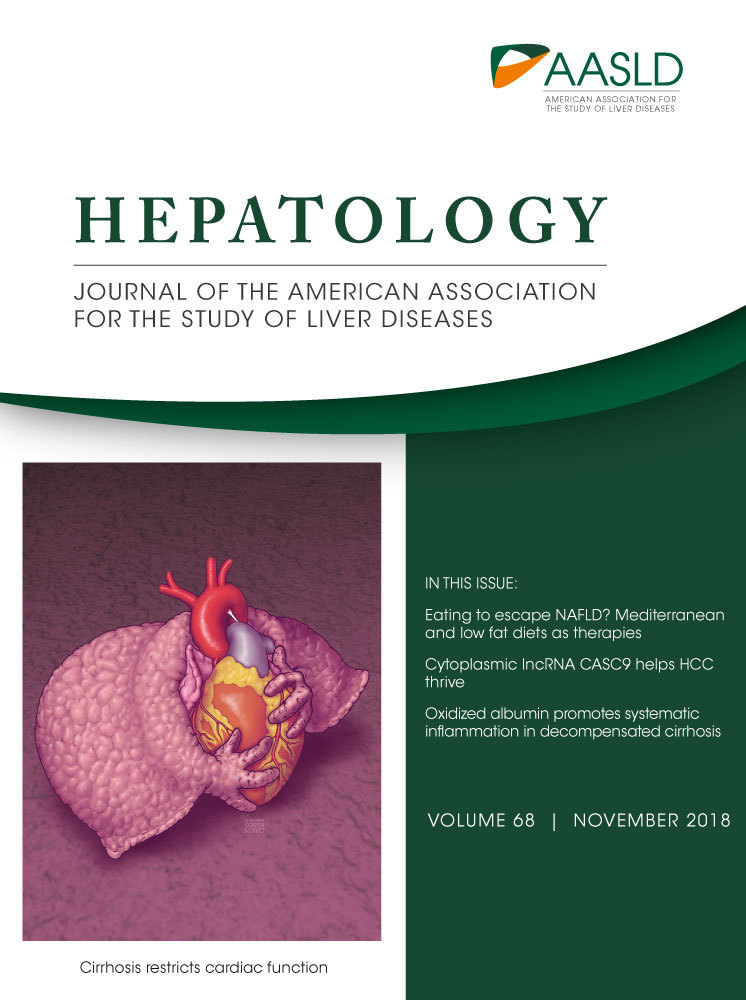Interleukin 2 Promotes Hepatic Regulatory T Cell Responses and Protects From Biliary Fibrosis in Murine Sclerosing Cholangitis
ADDRESS CORRESPONDENCE AND REPRINT REQUESTS TO:
Alexander G. Miethke, M.D.
Division of Pediatric Gastroenterology, Hepatology and Nutrition, Cincinnati Children’s Hospital Medical Center
Mail location 2010
3333 Burnet Avenue
Cincinnati, OH 45229-3026
E-mail: [email protected]
Tel.: +1-513-636-9078
Funding
Supported by the National Institutes of Health (NIH R01DK095001-05 [A.G.M], NIH T32DK007727-20 [PI: Lee Denson; support for A.E.T. and A.N.C.]); the Browner Family Foundation; the Weidner Bea Strong Family Funding; the “PSC Partners Seeking a Cure” foundation (A.G.M); National Institutes of Health Digestive Health Center (P30DK0783); American Association for Liver Diseases Foundation Advanced/Transplant Hepatology Fellow Award (A.E.T.); the National Institutes of Health Level VI Fellowship Award (A.N.C.); the American Liver Foundation Postdoctoral Research Fellowship Award (A.N.C.); the 2013 American Association for the Study of Liver Diseases Fellow Research Award (A.N.C.); and the University of Calgary Helios Scholarship (S.L.).
Abstract
In the multidrug resistance protein 2 (Mdr2)-/- mouse model, low phospholipid bile instigates biliary epithelial injury, sterile inflammation, and fibrosis, thereby recapitulating disease mechanisms implicated in biliary atresia (BA) and primary sclerosing cholangitis. We hypothesize that T lymphocytes contribute to the biliary injury and fibrosis in murine sclerosing cholangitis (SC) and that they are susceptible to suppression by regulatory T cells (Tregs). In juvenile Mdr2-/- mice, intrahepatic CD8+ lymphocytes were expanded, and contraction of intrahepatic Tregs coincided with rising serum alanine transferase and alkaline phosphatase (ALP) levels between days 14-30 of life. Antibody-mediated depletion of intrahepatic CD8+ lymphocytes during that time reduced ALP levels and the expression of osteopontin (Opn), a pro-fibrogenic cytokine. Depletion of intrahepatic Tregs with anti-CD25 antibody between days 7-30 increased intrahepatic CD8+ T cells, Opn expression, and fibrosis. Conversely, expansion of intrahepatic Tregs with interleukin 2/anti-interleukin 2 immune complexes (IL-2c) downregulated hepatic expression of Opn and Tnf, reduced frequency of intrahepatic CD8+ lymphocytes, and diminished biliary injury and fibrosis. Treatment with IL-2c upregulated hepatic Treg expression of CD39, an ectonucleotidase capable of hydrolyzing pro-inflammatory adenosine triphosphate. In vitro, Tregs expressing CD39 suppressed the proliferation of hepatic CD8+ lymphocytes from Mdr2-/- mice more efficiently than those lacking CD39. In infants with BA, infiltration of interlobular bile ducts with CD8+ cells was associated with biliary expression of Opn and its transcription was negatively correlated with mRNA expression of Treg-associated genes. Conclusion: Hepatic CD8+ T lymphocytes drive biliary injury and fibrosis in murine SC. Their proliferation is controlled by hepatic Tregs through the purinergic pathway, which is responsive to IL-2c, suggesting that Treg-directed low-dose Il-2 treatment may be considered as therapy for SC.
Abbreviations
-
- ALP
-
- alkaline phosphatase
-
- ALT
-
- alanine transaminase
-
- BA
-
- biliary atresia
-
- BALB/c
-
- Bagg albino
-
- EGFP
-
- enhanced green fluorescent protein
-
- FACS
-
- fluorescence-activated cell sorting
-
- FFPE
-
- formalin-fixed paraffin-embedded
-
- GFP
-
- green fluorescent protein
-
- GWAS
-
- genome wide association studies
-
- H&E
-
- hematoxylin and eosin
-
- IgG
-
- immunoglobulin G
-
- IL-2c
-
- Interleukin 2/anti-interleukin 2 immune complexes
-
- i.p.
-
- intraperitoneal
-
- Mdr
-
- multidrug resistance protein
-
- MNC
-
- mononuclear cell
-
- Opn/OPN
-
- osteopontin
-
- PBS
-
- phosphate-buffered saline
-
- PAN-CK
-
- pan-cytokeratin
-
- PSC
-
- primary sclerosing cholangitis
-
- SC
-
- sclerosing cholangitis
-
- Tregs
-
- regulatory T cells
Fibrosing cholangiopathies including biliary atresia (BA) and primary sclerosing cholangitis (PSC) are characterized by inflammation and fibrosis centered on biliary epithelium with progressive cholestasis, bile duct proliferation, periductal sclerosis, and hepatic fibrosis, resulting in end-stage liver disease that may require liver transplantation.1, 2 Adaptive immune responses are implicated in the pathogenesis of both conditions. In patients with BA, both the liver and bile duct remnants are infiltrated by inflammatory cells enriched in CD8+ lymphocytes.3 Furthermore, the presence of CD8+ T lymphocyte oligoclonal expansion suggests effector lymphocyte proliferation in response to a cognate antigen during the development of BA. In PSC, aberrant homing of gut-derived lymphocytes including CD8+ T cells has long been described as a central component of immune-mediated bile duct injury.4 Yet, to what extent CD8+ lymphocytes contribute to the progression of fibrosis in both conditions is largely undefined.
Regulatory T cells (Tregs), expressing the master regulatory transcription factor FOXP3, play an integral role in modulating inflammation and autoimmunity in disorders such as rheumatologic disease, graft-versus-host disease, inflammatory bowel disease, and liver allograft tolerance following transplantation. In addition, Treg dysfunction has been linked to the effector immune response in the pathogenesis of BA, supported by reduced proportions of Tregs in peripheral blood at the time of diagnosis and increased lymphocyte reactivity to cytomegalovirus antigen.5 In patients with PSC, genome-wide association studies (GWAS) have identified gene polymorphisms encoding lymphocyte receptors on both effector cells and Tregs associated with an increased risk of PSC: the costimulatory receptor CD28 expressed on CD8+ effector lymphocytes and IL2RA (CD25) highly expressed on Tregs, respectively.6-8 The IL2RA polymorphism in patients with PSC was associated with decreased Treg number and suppressive function.8 Furthermore, a recent meta-analysis of published GWAS and liver transcriptomic studies revealed common disease pathways and central roles for FOXP3, STAT3, IL6, and TNF in the three most common cholangiopathies: PSC, BA, and primary biliary cirrhosis.9
Of note, predisposition to pediatric autoimmune liver disease has recently been linked to dysfunction of Tregs expressing CD39.10 CD39 is a member of the ectonucleoside triphosphate diphosphohydrolase family, which has been shown to hydrolyze pro-inflammatory adenosine triphosphate (ATP) to adenosine diphosphate and finally adenosine, which inhibits cytotoxic lymphocyte activation and reduces production of pro-inflammatory cytokines upon activation of the adenosine A2A receptor.11, 12 CD39 stabilizes the suppressor phenotype of Tregs under inflammatory conditions and enhances their suppressor activity.13 There is emerging evidence that CD39+ CD4+ cells prevent ischemia reperfusion inflammatory liver injury, promote liver allograft tolerance in mice, and have profound effects on antitumor immune surveillance in the liver.14-17
The multidrug resistance protein 2 (Mdr2) (Abcb4) knockout mouse is an established preclinical model of fibrosing cholangiopathy, whereby absence of the phospholipid floppase Mdr2 at the hepatocyte canalicular membrane results in “toxic” low phospholipid bile, precipitation of unopposed biliary bile acid and cholesterol, and subsequent sterile inflammation driving bile duct epithelial injury and rapidly progressive biliary fibrosis.18 The mice develop sclerosing cholangitis (SC) with cholestasis, bile duct proliferation, and bridging fibrosis.19, 20 In this model, there is altered expression and cellular localization of canalicular transporters early in the disease course, microcrystal formation in bile ducts, bile leak, and disruption of basement membranes with subsequent sterile inflammation and neutrophil-recruitment to sites of injury.18, 21 Progression of biliary fibrosis in Mdr2-/- mice, which is established by 12 weeks of age and associated with portal hypertension, recapitulates progression of fibrosis in PSC and BA.19
Although the contribution of adaptive immunity to disease initiation and progression of BA is well established in rotavirus-induced murine neonatal bile duct obstruction, the roles of CD8+ lymphocytes and Tregs in sterile inflammation, specifically of hepatobiliary injury and fibrosis in Mdr2-/- mice, are largely unknown.22, 23 We sought to further delineate the crosstalk between Tregs and effector lymphocytes in Mdr2-/- mice as a model of noninfectious rapidly progressive fibrosing cholangiopathy. We hypothesize that CD8+ T lymphocytes are integral in the initiation of biliary epithelial injury and fibrosis in murine SC and are susceptible to control by CD39+ Tregs through modulation of the purinergic pathway of lymphocyte activation.
Materials and Methods
Human Studies
Hepatic Microarray Studies
Relative expression for SSP1 and Treg-associated genes originated from hepatic microarray studies carried out on infants with extrahepatic biliary atresia at the time of diagnosis by intrahepatic cholangiograms.24 Detailed information on handling of liver biopsy samples, RNA labeling, chip hybridization, normalization procedures, and analysis of gene expression were deposited in Gene Expression Omnibus (GEO: GSE46995). In this study, complimentary RNA pools were hybridized to oligonucleotide-based human HG-U133 Plus 2.0 Array (Affymetrix, Santa Clara, CA) containing 54,681 probe sets. The study protocols conformed to the ethical guidelines of the 1975 Declaration of Helsinki and were approved by the human research committees of all participating institutions.
Immunofluorescence
Archived 4-m formalin-fixed paraffin-embedded (FFPE) liver sections from de-identified patients with BA were obtained from the BioBank at Cincinnati Children’s Hospital Medical Center. Sequential heat-induced epitope retrieval, incubation with primary and with horseradish peroxidase–conjugated secondary antibodies, and tyramide signal amplification were performed using the PerkinElmer Tyramide Signal Amplification Kit (OP7TL2001KT; PerkinElmer), according to manufacturer recommendations. Ethylene diamine tetraacetic acid (pH = 9) was used for antigen retrieval prior to incubation with antibodies against CD8 (clone SP57; Ventana Medical Systems, neat) or cytokeratin (clone pan-cytokeratin [PAN-CK]; ThermoFisher Scientific, 1:100 dilution), whereas citrate buffer (pH = 6) was used before staining with antibodies against osteopontin (Opn) (clone AF1433; R&D Systems, Inc., 1:1000). Images were captured through automated tile scanning with an inverted Nikon Eclipse TiE widefield microscope (Nikon Instruments, Inc., Tokyo) mounted with a fully motorized stage at 20x magnification with 1% overlap. Image analysis was performed on tiled images using Nikon Elements Advanced Research.
Murine Studies
Mice in a Bagg albino (BALB/c) background with Mdr2 deletion, a generous gift from Professor Lammert (Homburg University; Homburg, Germany), were crossed with BALB/c mice transgenic for FoxP3–enhanced green fluorescent protein (EGFP) (Jackson Laboratory) to precisely track Tregs during SC progression. Mice were bred in-house and maintained in pathogen-free animal facilities with temperature regulation and a 12-hour dark/light cycle. They were fed 5020 breeder chow with 9% fat (Cincinnati Lab Supply, Cincinnati, OH). To demonstrate the role of effector lymphocytes on hepatobiliary injury, male Mdr2-/- mice transgenic for FoxP3–green fluorescent protein (GFP) received intraperitoneal (i.p.) injections of antibody-depleting CD8+ lymphocytes (100 μg/dose; clone YTS169.4, BioXcell) or isotype control IgG2b (100 μg/dose; clone LTF-2, BioXcell) twice weekly between day of life 15 and 30. Mice were given i.p. injections of anti-CD25 antibody (250 μg/dose; clone PC-61.5.3, BioXcell) or isotype control IgG1 (250 μg/dose; HPRN, BioXcell) twice weekly between day of life 7 and 30 for Treg depletion. The Mdr2-/- and +/- mice transgenic for FoxP3-GFP were subjected to i.p. administration of recombinant murine interleukin (IL)-2 (0.01 µg/g; Catalog # 212-12, PeproTech) complexed to anti-IL2 (0.05 µg/g; clone Jes6-1A12, BioXCell) or phosphate-buffered saline (PBS) control twice weekly from day of life 8 until 30. The animal care and use committee of the Cincinnati Children’s Research Foundation (Cincinnati, OH) approved the protocols used in these studies.
Mononuclear Cell Isolation, Flow Cytometry, Gene Expression Studies, Protein Blot Analysis, Plasma Biochemistry and Cytokine Quantifications, Immunohistochemistry, and Immunofluorescence
These methods were performed as described by our group.25-27 Details are available in the supporting information.
Histological Analysis
Blinded analysis using a validated, semi-quantitative scale from 1-4+ for bile duct proliferation was performed by pathologist K.S. on hematoxylin and eosin (H&E) stained liver sections. Masson’s trichrome stained-liver sections were subjected to Aperio image analysis, as previously described.27, 28 Image analysis of Opn-, CK-19-, and sirius red–stained liver sections was performed by digital scanning of liver sections at 10x using a Nikon H550S. Scanned slides were analyzed by a fraction of 3,3´-diaminobenzidine positive area or collagen staining in up to 15 randomly selected 1000 x 1000-um sections per each liver sample using NIS-Elements software (Nikon Instruments, Inc.).
Cell Culture Proliferation Assays
Splenic and hepatic CD8+ lymphocytes were isolated using beads (DynaBeads; ThermoFisher Scientific, Waltham, MA) and subjected to CellTrace Violet staining at a concentration of 5 µM (ThermoFisher Scientific) prior to culture assay. Bead isolation (Miltenyi Biotec, Cambridge, MA) of splenic mononuclear cells yielded CD4+ cells and were further isolated into CD25+ or 25- cells using the kit. Fluorescence-activated cell sorting (FACS) (BD FACSARIA 1 and II; BD Bioscience, Franklin Lakes, NJ) was used to separate Tregs based on expression of CD39. Cells at a concentration of 70,000/well were incubated in 96-well plates coated with 1 µg/mL of anti-CD3e (clone 145-2C11, eBioscience) and 1-µg/mL anti-CD28 (clone 37.51, eBioscience) for 3 days in medium containing Roswell Park Memorial Institute 1640 medium with 10% fetal calf serum, 1% penicillin/streptomycin, 1% L-glutamine, and 100-IU/mL human IL2.
Statistical Analysis
Differences of continuous variables between groups were assessed for statistical significance using the Student t test with a P value < 0.05. Charts were generated using GraphPad Prism version 7 (GraphPad, La Jolla, CA). PROC GPLOT in SAS was used to generate spline curves, fitting the observed numbers of liver-infiltrating CD8 and Treg lymphocytes between day 8 and 45 of life.
Results
Infiltration of the Liver by CD8+ T Lymphocytes Precedes Manifestations of the SC Phenotype in Juvenile Mdr2-/- Mice
To examine the temporal relationship between toxic bile-induced development of the SC phenotype and the kinetics of hepatic effector lymphocyte and Treg responses, we evaluated liver sections and biomarkers of hepatocellular and biliary injury as well as intrahepatic lymphocyte composition in Mdr2-/- mice transgenic for FoxP3-EGFP at defined time points between 8 and 45 days of life using FoxP3-EGFP Mdr2+/- mice as controls. The alanine aminotransferase (ALT) and ALP levels were similar between both groups at days of life 8 and 14. Yet, ALT and ALP levels were significantly higher in Mdr2-/- compared with Mdr2+/- control mice beginning at day 30 (Fig. 1A). Biochemical evidence of hepatobiliary injury in Mdr2-/- mice was temporally associated with histological evidence of SC, such as bile duct proliferation and periportal infiltration by inflammatory cells (Fig. 1B) and portal fibrosis (Fig. 1C) at day 30. By day 45, the SC phenotype was fully developed with persistence of high ALT and ALP, increased bile duct proliferation, and portal-portal bridging of inflammatory infiltrates and fibrosis. Composition of liver infiltrating lymphocyte populations was determined at the 4 time points by flow cytometry and spline curves fitting the numbers of cells per time point were generated to delineate the kinetics of hepatic CD8 and Treg responses in Mdr2-/- mice and in Mdr2+/- control mice without liver injury (Fig. 1D). On average, numbers of intrahepatic CD8+ cells were higher in Mdr2-/- mice compared with age-matched Mdr2+/- mice at all time points and followed a cubic pattern with two inflection points in both genotypes (early trough at 15 days followed by temporary rise at 30 days). Although emergence of hepatic Tregs followed a similar cubic pattern in Mdr2+/- mice, its kinetic appeared to be disrupted in Mdr2-/- mice with only a quadratic pattern (one inflection point). The Treg to CD8+ lymphocyte ratio is highest at day 15 in Mdr2-/- mice, but as their Tregs steadily decline in number after day 15 and CD8+ lymphocytes increase to day 30, the observed ratio at day 30 is the lowest, at which point liver injury becomes evident in Mdr2-/- mice. Temporal association between high Treg/CD8 ratios and lack of detectable liver injury at early time points raised the biological possibilities that CD8+ cells contribute to liver injury in SC and that Tregs were capable of constraining CD8-mediated injury in this model.
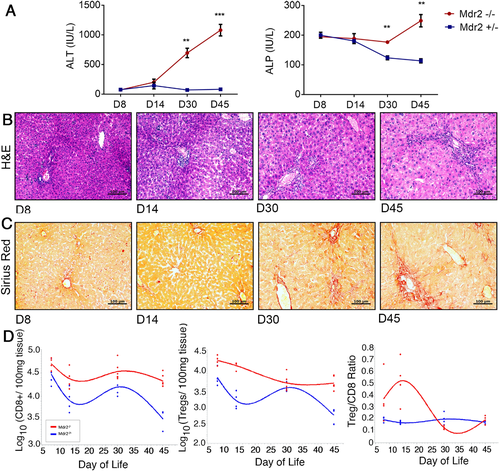
Depletion of Effector Lymphocytes Diminishes Hepatobiliary Injury
To examine the role of CD8+ lymphocytes in the initiation of bile duct injury in juvenile Mdr2 -/- mice, immunofluorescent staining was performed on liver sections from Mdr2-/- mice. It revealed localization of CD8+ lymphocytes in close proximity to bile duct epithelial cells (Fig. 2A). Administration of antibodies depleting CD8+ lymphocytes between day 15 and 30 greatly reduced hepatic CD8+ lymphocytes (Fig. 2B), decreased portal inflammation and diminished bile duct proliferation (Fig. 2C), and correspondingly lowered serum ALP levels (Fig. 2D). Opn, a profibrogenic Th1 cytokine, has previously been linked to progression of fibrosis in human BA.29, 30 In Mdr2-/- mice, Opn expression was detected by immunohistochemistry in interlobular bile ducts, bile ductules, proliferating cholangiocytes, and zone 1 hepatocytes. We found that depletion of CD8+ lymphocytes reduced Opn expression by 64% (Fig. 2E), indicating that CD8+ lymphocytes may instigate biliary fibrosis in Mdr2-/- mice through biliary epithelial injury.
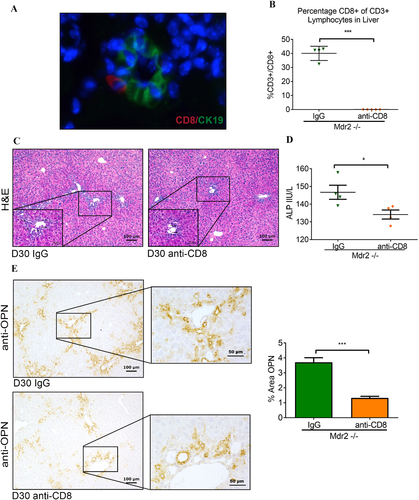
Depletion of Hepatic Tregs Increases Hepatobiliary Injury and Fibrosis
Prompted by the observation that contraction of hepatic Tregs coincided with expansion of liver-infiltrating CD8 lymphocytes and initiation of SC in Mdr2-/- mice, we further examined this relationship in Treg-depletion experiments. When anti-CD25 antibody was administered between days 7 and 30, the frequency of hepatic Foxp3+Tregs decreased by more than 80% (Fig. 3A). Although the frequency of total hepatic CD4+/CD3 cells did not change (data not shown), the frequency of hepatic CD8+ lymphocytes in CD25-treated Mdr2-/- mice rose by 40%. Plasma levels for Tnf increased by more than 2-fold compared with immunoglobulin G (IgG)-treated Mdr2-/- mice (Fig. 3B). Depletion of Tregs not only resulted in more portal inflammation (Fig. 3C) but also accelerated bile duct proliferation, as assessed by image analysis of CK19-stained bile duct profiles (Fig. 3D), serving as surrogate histopathological marker for biliary injury in SC. Treatment of Mdr2-/- mice with CD25 antibodies induced expression of Opn in BECs and periportal stromal cells (Fig. 3E), which was associated with increased hepatic fibrosis, as assessed by image analysis of sirius red–stained liver sections (Fig. 3F).
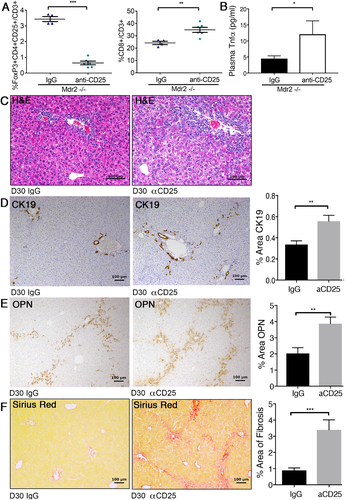
Cytokine-Induced Expansion of Hepatic Tregs Suppressed Hepatic Effector CD8+ Lymphocyte Responses
Next, we adopted a complementary approach and expanded Tregs in Mdr2-/- mice by administrating IL-2c between days 8 and 30. IL-2c has previously been shown to expand Tregs while blocking IL-2 agonistic effects on CD8+ and NK lymphocyte populations.31 Treatment with IL-2c significantly increased the frequency of Tregs/CD3+ lymphocytes by more than 100% in Mdr2+/- mice and by 50% in Mdr2-/- compared with PBS-treated age-, gender-, and genotype-matched control animals (Fig. 4A). Augmentation of the Tregs was accompanied by significant reduction of hepatic CD8+ lymphocytes in Mdr2-/- mice (but not in noncholestatic Mdr2+/- mice) and an increase in Treg/CD8+ ratio by more than 2-fold. IL-2c treatment did not affect the proportions of hepatic NK cells (data not shown). Flow-cytometric findings were corroborated by down-regulation of mRNA expression for the CD8a gene (Fig. 4B). Furthermore, hepatic expression of genes implicated in T cell polarization (Stat4) and inflammation (Nfkb1, Il1a) were reduced in Mdr2-/- mice treated with IL-2c as revealed by multiplex gene expression studies. Candidate gene quantitative PCR studies showed significant down-regulation of hepatic expression for Spp1 (encoding Opn) and Tnfa in IL-2c-treated Mdr2-/- mice (Fig. 4C). Immunoblotting on corresponding liver samples demonstrated reduced hepatic Tnf protein expression in IL-2c-treated Mdr2-/- mice (Fig. 4D).
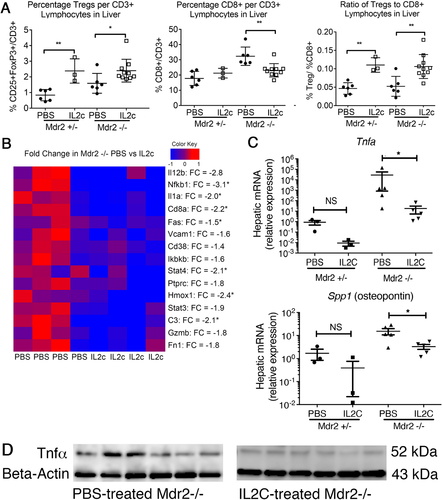
Expansion of Tregs Reduces Cholestasis, Biliary Injury, and Fibrosis
To evaluate whether cytokine-induced expansion of hepatic Tregs modulates the SC phenotype in Mdr2-/- mice, liver histopathology was assessed on H&E-stained liver sections using a validated 1-4+ scale. Blinded review showed lower scores for bile duct proliferation in IL-2c-treated Mdr2-/- mice (Fig. 5A,B). Reduced biliary injury was corroborated by results of image analysis of percent area of CK19+ cells (Fig. 5C) and by significantly lower ALP levels in IL-2c-treated Mdr2-/- mice (Fig. 5D). Decreased biliary injury was accompanied by halted progression of fibrosis in IL-2c-treated Mdr2-/- mice, as shown by down-regulation of mRNA expression of the pro-fibrogenic gene smooth muscle actin (SMA; Fig. 5E) and 50% reduction in fibrosis as determined by image analysis of trichrome-stained liver sections (Fig. 5F).
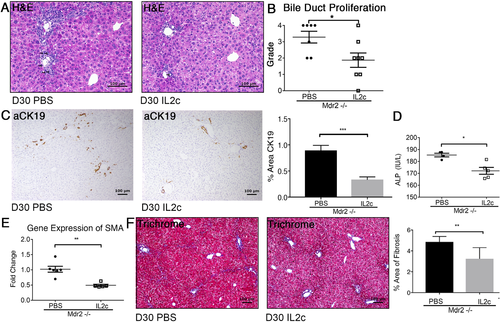
Tregs Display an Activated Phenotype and Increased Ectonucleotidase Expression in Response to IL-2c In Vivo
To determine the effects of IL-2c on Tregs infiltrating the liver at the site of inflammation in Mdr2-/-, we determined the molecular phenotype of Tregs from livers and spleens of knockout and age-matched control mice using flow cytometry. Treatment with IL-2c significantly upregulated the activation marker ICOS on both hepatic and splenic Tregs in Mdr2-/- mice (Fig. 6A). GITR, a corticosteroid-induced TNF receptor, is a costimulatory molecule expressed on T cells including Tregs.32 GITR was abundantly expressed on hepatic and splenic Tregs at baseline in Mdr2-/- mice (Fig. 6B). Il-2c significantly upregulated GITR on liver-infiltrating Tregs in noncholestatic Mrd2+/- mice, but not in Mdr2-/- mice, indicating that the response of Tregs to IL-2c depends on the tissue microenvironment. High CD39 expression was restricted to Tregs in the liver (>40%) of untreated Mdr2-/- and +/- mice, as opposed to the spleen, and IL-2c treatment promoted a further surge of hepatic CD39+Tregs in Mdr2-/- mice (Fig. 6C). Based on published data on the role of CD39+Tregs in inflammatory liver diseases, their higher frequency in the liver of Mdr2-/- mice compared with secondary lymphoid organs (spleen), and their response to Il-2c treatment, we hypothesized that CD39 was important in mediating Treg suppression of CD8+ lymphocytes in SC.
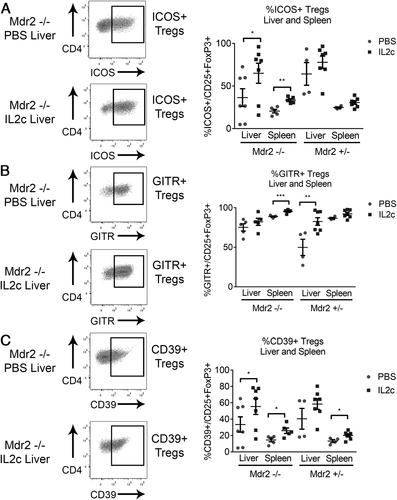
CD39+ Tregs Efficiently Suppress Proliferation of Hepatic CD8+ Lymphocytes From Mdr2-/- Mice
Coculture experiments were performed to determine the direct effect of Tregs on CD8 proliferation. In vitro, isolated splenic CD8+ cells proliferated better with the addition of non-Treg CD25-CD4+ lymphocytes, as demonstrated by reduction of the percentage of nonproliferating CD8+ lymphocytes from 50.6 to 14.2%. Coculture with CD4+CD25+ Tregs failed to boost proliferation (Fig. 7A). To examine whether the purinergic pathway is involved in the control of CD8+ lymphocyte activation and proliferation in SC, we determined expression of the adenosine A2A receptor, a GS-protein that leads to intracellular accumulation of cAMP promoting inhibitory cellular responses, on CD8+ lymphocytes and found that hepatic CD8+ cells from Mdr2-/- mice upregulated A2A receptor when cocultured with Tregs (Fig. 7B). Next, we investigated whether the CD39-A2A receptor immunoregulatory circuit is relevant in control of CD8 proliferation in SC. Tregs from IL-2c-treated Foxp3 EGFP mice were separated into CD39+ and CD39- populations by FACS and subsequently cocultured with hepatic CD8+ lymphocytes from Mdr2-/- mice (Fig. 7C). Only CD39+ Tregs, but not CD39- Tregs, inhibited proliferation of hepatic CD8+ lymphocytes from Mdr2-/- mice compared with coculture with non-Treg CD4+ cells (Fig. 7D). Our in vitro data demonstrate an important role for inhibition of hepatic CD8+ lymphocyte responses in Mdr2-/- mice, which is restricted to CD39+Tregs capable of direct suppression of proliferation that involves hydrolysis of pro-inflammatory ATP and suppressor effects of adenosine on A2A receptor+CD8+ lymphocytes. Immunotherapy with IL-2c expands this potent subset of CD39+Tregs in the liver of Mdr2-/- mice.

Biliary Infiltration With CD8+ Lymphocytes Is Associated With OPN Expression in Infants With BA at Diagnosis
The FFPE liver sections from 8 patients with BA at diagnosis (5 males, mean age 55 days) were subjected to multiparameter immunofluorescence against PAN-CK, CD8, and OPN, and subsequent image analysis. The mean area of liver tissue imaged was 86.2 ± 14.3 mm2 per patient. CD8+ cells accumulated in the portal tracts (Fig. 8A). CD8+ cells infiltrating biliary epithelium (iCD8) were identified by CD8+ cells overlapping with areas of cytokeratin, and the degree of CD8 infiltration varied between portal tracts and patients (Fig. 8B,C). Similar to our results in the murine model, OPN was primarily localized to interlobular bile ducts, bile ductules, and proliferating cholangiocytes, with relatively minor expression in hepatocytes. Bile ducts with a high grade of CD8 infiltration expressed more OPN than cholangiocytes without iCD8 (Fig. 8B,C). Using image analysis, we found significant correlation between expression of OPN by cholangiocytes and number of iCD8 cells (Fig. 8D). To test for an association between expression of SPP1 and Tregs, we surveyed previously performed microarray-based gene expression data on 47 patients with BA at diagnosis.24 Applying a principle component analysis to a set of 700 probes of Treg-associated genes revealed that expression values for genes like THBS1, HDAC2, HDAC4, HDAC7, HDAC9, DICER1, and RUNX1 were negatively correlated with expression of SPP1, indicating that similar to our results in murine SC, Tregs may suppress hepatic OPN expression in infants with BA (Fig. 8E).
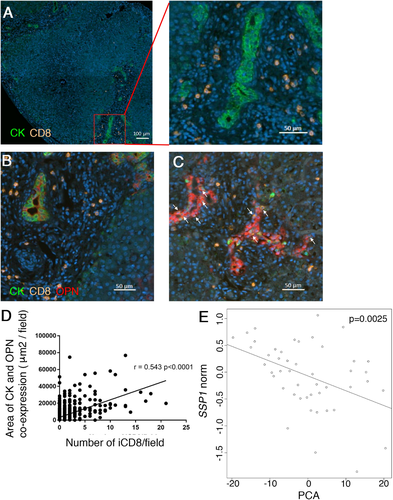
Discussion
Here we report that waning intrahepatic Treg responses in juvenile Mdr2-/- mice coincide with expansion of intrahepatic CD8+ lymphocytes and initiation of hepatocellular and bile duct epithelial injury and fibrosis. In vivo manipulation of Tregs in Mdr2-/- mice demonstrated an influence of hepatic Tregs on liver-infiltrating CD8+ cells, biliary injury, Opn expression, and fibrosis. Direct control of CD8 proliferation by Tregs depends on modulation of purinergic pathways of effector lymphocyte activation through CD39. In infants with BA, infiltration of intrahepatic bile ducts with CD8+ cells is associated with aberrant expression of OPN at time of diagnosis, validating aspects of our findings in the experimental model of SC for human fibrosing cholangiopathies.
Experiments involving depletion of CD8+ lymphocytes in juvenile Mdr2-/- mice highlight their role in SC; CD8-depleted animals display less biliary injury, as evidenced by reduced bile duct proliferation and lower serum ALP levels as biomarkers of cholangiocyte injury.33, 34 CD8+ T lymphocytes have been assigned pathogenic effector functions in a spectrum of immune-mediated liver diseases, including autoimmune hepatitis and PSC.35 A specific subset of CD8+ lymphocytes with absent expression of the regulatory molecule CD28 was enriched in livers of patients with PSC and secreted increased TNFα upon stimulation.7 CD8+ lymphocyte injury was also found to be integral in the neonatal bile duct injury of BA.5, 36 Previous studies have focused on the roles of CD8+ lymphocytes following viral infection affecting the biliary tree or in adoptive transfer models using immunocompromised mice and antigen-specific T lymphocytes to generate cholangitis.22, 37 Our studies provide evidence that CD8+ lymphocytes are also important for initiation of cholangiocyte injury and fibrosis in the Mdr2-/- murine model of SC, which lacks an infectious insult or genetic predisposition to immune-mediated injury.
CD8+ lymphocyte depletion reduces expression of Opn, a pro-fibrogenic cytokine and driver of bridging fibrosis, suggesting that effector CD8+ cells perpetuate biliary fibrosis through induction of Opn expression in murine SC. Recent studies have demonstrated OPN to be a cytokine with pleiotropic effects on cell proliferation, migration, inflammation, and fibrosis.38-40 In experimental models of cholestasis, Opn has been linked to hepatic fibrosis through modulation of transforming growth factor β and subsequent interaction with hepatic stellate cells and their transformation into collagen-1 secreting myofibroblasts.40 In human disease, OPN expression is correlated with the stage of biliary fibrosis in infants with BA.30 Based on our findings in the Mdr2-/- mouse and in liver samples from infants with BA, we propose that CD8+ lymphocytes are activated early in the pathogenesis of SC, contributing to the bile duct epithelial injury, and through induction of OPN in biliary and stromal cells to initiation of biliary fibrosis.
Importantly, we found that both CD8 responses and the SC phenotype are controlled by Tregs in Mdr2-/- mice. Depletion of Tregs with anti-CD25 antibodies promotes infiltration of the liver with CD8+ lymphocytes, raises levels of circulating Tnf, aggravates bile duct proliferation, induces Opn expression by biliary epithelial and periportal stromal cells, and ultimately enhances fibrosis. In contrast, IL-2c-mediated expansion of Tregs diminishes hepatic CD8 responses, down-regulates pro-inflammatory and Th1 cytokine production in the liver (Opn and Tnf), and attenuates the SC phenotype. The latter results lend functional significance to GWAS, which identified risk alleles in IL-2 and IL2RA in patients with PSC,6, 41 suggesting that alterations in the IL-2 pathway and subsequent effects on Treg homeostasis may represent important susceptibility factors for disease pathogenesis. Here we show in Mdr2-/- mice recapitulating the biliary fibrosis observed in PSC, that hepatic Treg homeostasis depends on IL-2, and that low-dose IL-2 treatment is able to overcome Treg deficits by increasing their number and activation status as evidenced by upregulation of ICOS and CD39 with beneficial effects for the liver disease phenotype, including bile duct proliferation and fibrosis. However, compared with noncholestastic Mdr2+/- mice, the response of Mdr2-/- mice to treatment with IL-2c is attenuated, indicating that cholestasis and/or the pro-inflammatory microenvironment in the liver of Mdr2-/- may partially block the mitogenic effects of IL-2 on Tregs. Future investigations need to reveal the mechanisms by which Treg homeostasis is altered under cholestatic conditions and how Treg-targeted immunotherapy can be optimized for these liver diseases. Resistance of Tregs to mitogens under certain conditions may explain that IL-2 treatment failed to protect Mdr2-/- mice from cholangitis in a recent study by a different group of investigators.42 This study was conducted in female C57BL6 Mdr2-/- as opposed to male BALB/c Mdr2-/- mice used in our study. Worse cholestasis in female versus male mice may have contributed to the resistance of Tregs.43 Effects of IL-2c treatment on expansion of CD39+ Tregs, CD8+ lymphocyte responses, Opn induction, and progression of biliary fibrosis was not investigated in that study.
Suppressive and anti-inflammatory ectonucleotidases such as CD39 have been suggested previously to provide a “molecular switch” to dampen tissue damage from liver inflammation.44 We report that CD8+ lymphocytes from Mdr2-/- mice upregulate A2A when cocultured with CD4+ lymphocytes and assign a critical role for CD39 in mediating Treg-suppressor function. Only Tregs expressing CD39 but not CD39- Tregs are capable of inhibiting the proliferation of hepatic CD8+ lymphocytes from Mdr2-/- mice in vitro. Furthermore, treatment with Il-2c not only increases the overall frequency of hepatic Tregs, but in particular the proportion of CD39+ Tregs in livers of Mdr2-/- mice, suggesting that the suppressive effects of IL-2 treatment on liver-infiltrating CD8 lymphocytes and subsequent hepatobiliary injury in SC are mediated by CD39+ Tregs. This observation may be relevant for treatment considerations in PSC, in which CD8+ lymphocytes lack CD28 and are therefore resistant to Treg control of dendritic cell–dependent costimulation (i.e., through CTLA-4), but may remain susceptible to direct inhibition by Tregs using the CD39-A2A immunoregulatory circuit.
We therefore conclude that in the Mdr2 -/- model of fibrosing cholangiopathy with prominent sterile inflammation and rapid progression of fibrosis similar to those found in most children with BA and in a subset of patients with PSC, CD8+ lymphocytes contribute to bile duct epithelial injury and, through OPN expression, to fibrosis. These processes are susceptible to immunotherapy-targeting Tregs, such as low-dose IL-2, which boosts intrahepatic Tregs, diminishes CD8 responses, attenuates biliary injury, and halts progression of fibrosis in this preclinical model. The purinergic suppressor pathway involving CD39 on Tregs and A2A on CD8+ cells is of particular importance in SC. Collectively, based on the results of our preclinical studies and of clinical trials in immune-mediated liver disease, low-dose IL-2 treatment should be considered as adjuvant therapy for fibrosing cholangiopathies like BA and PSC in the future.45, 46
Potential Conflict of Interest
Nothing to report.



